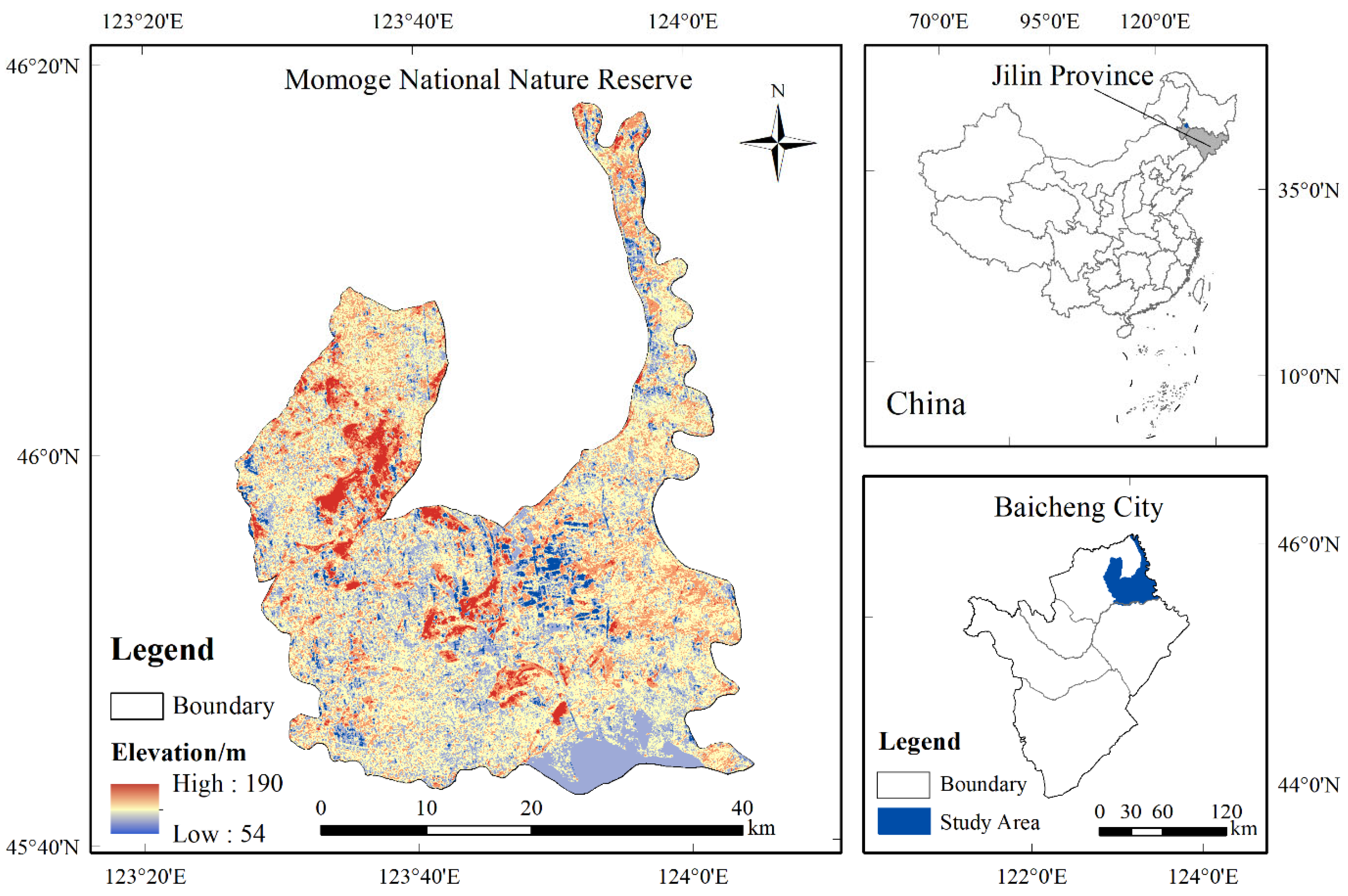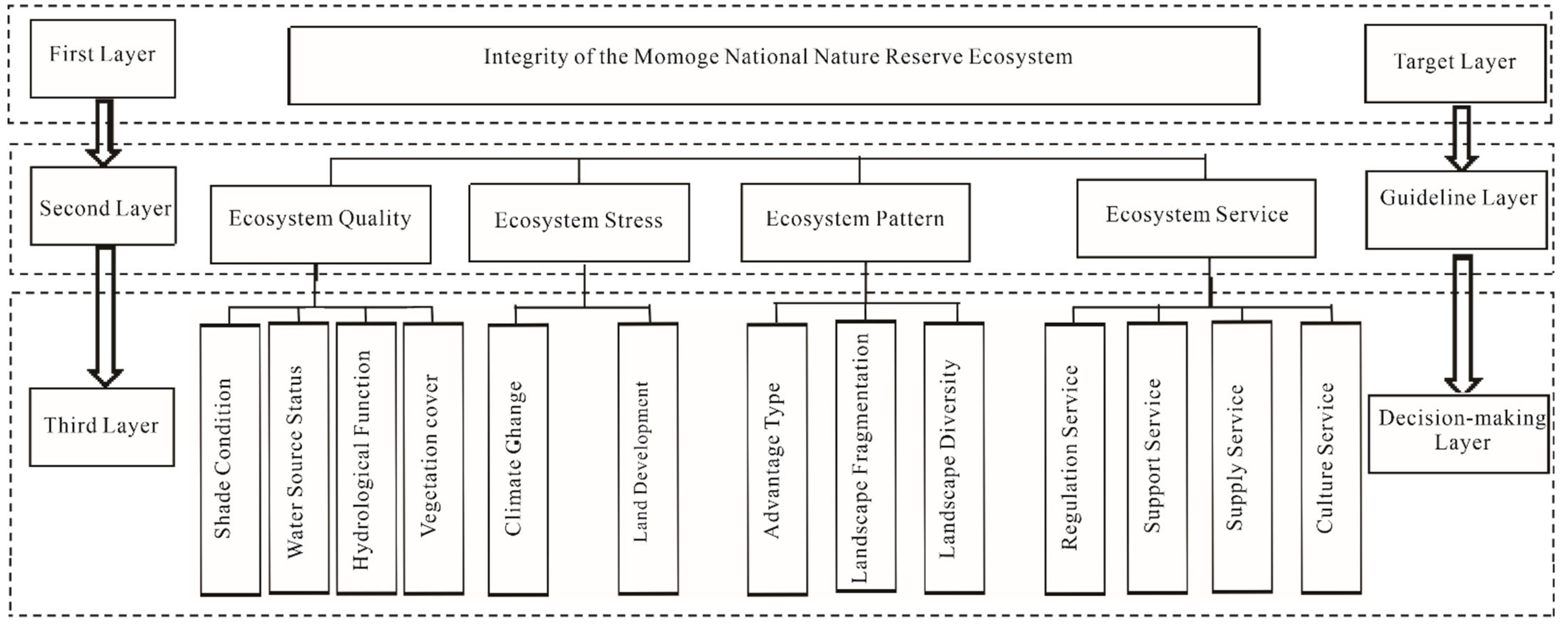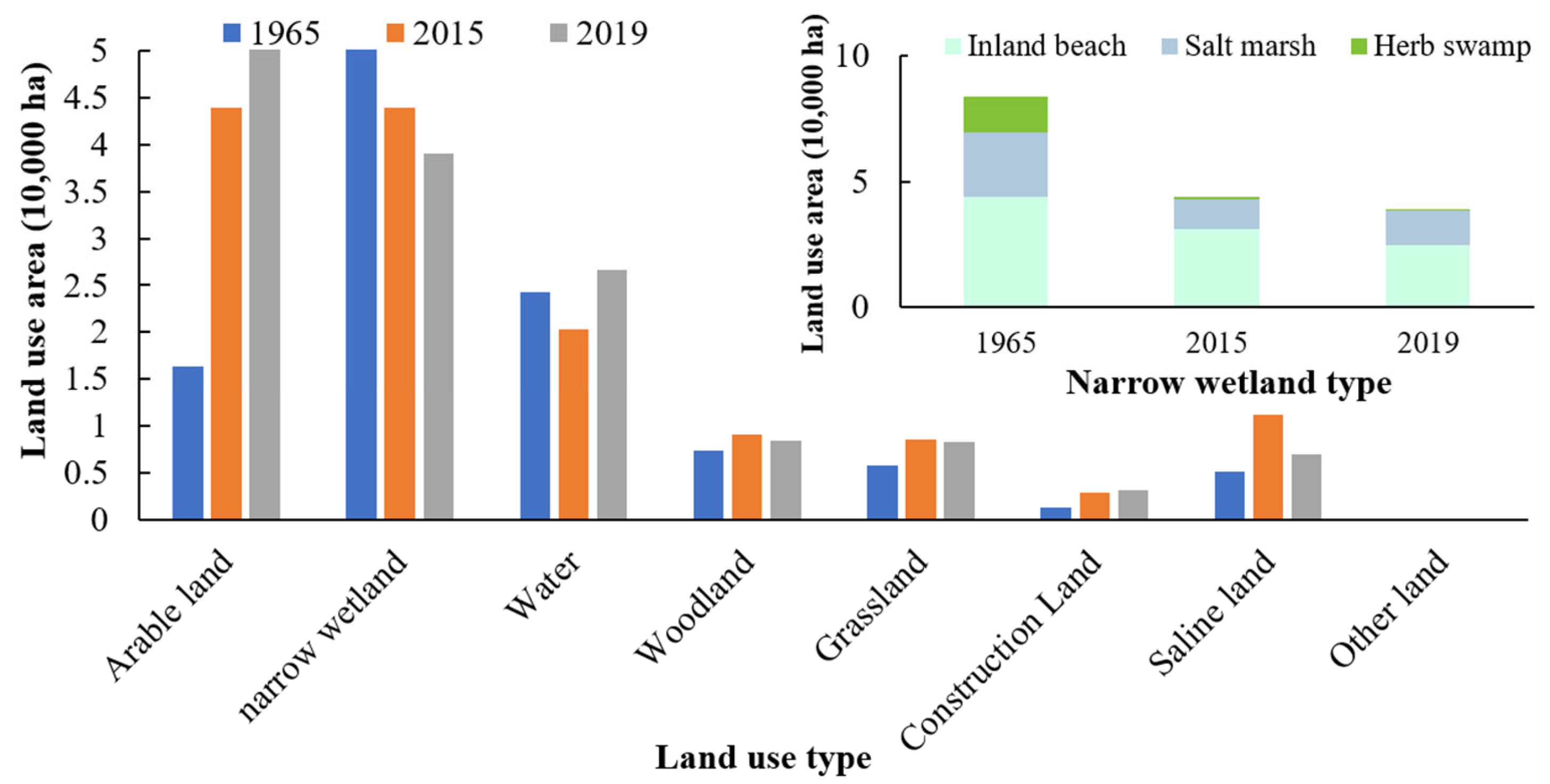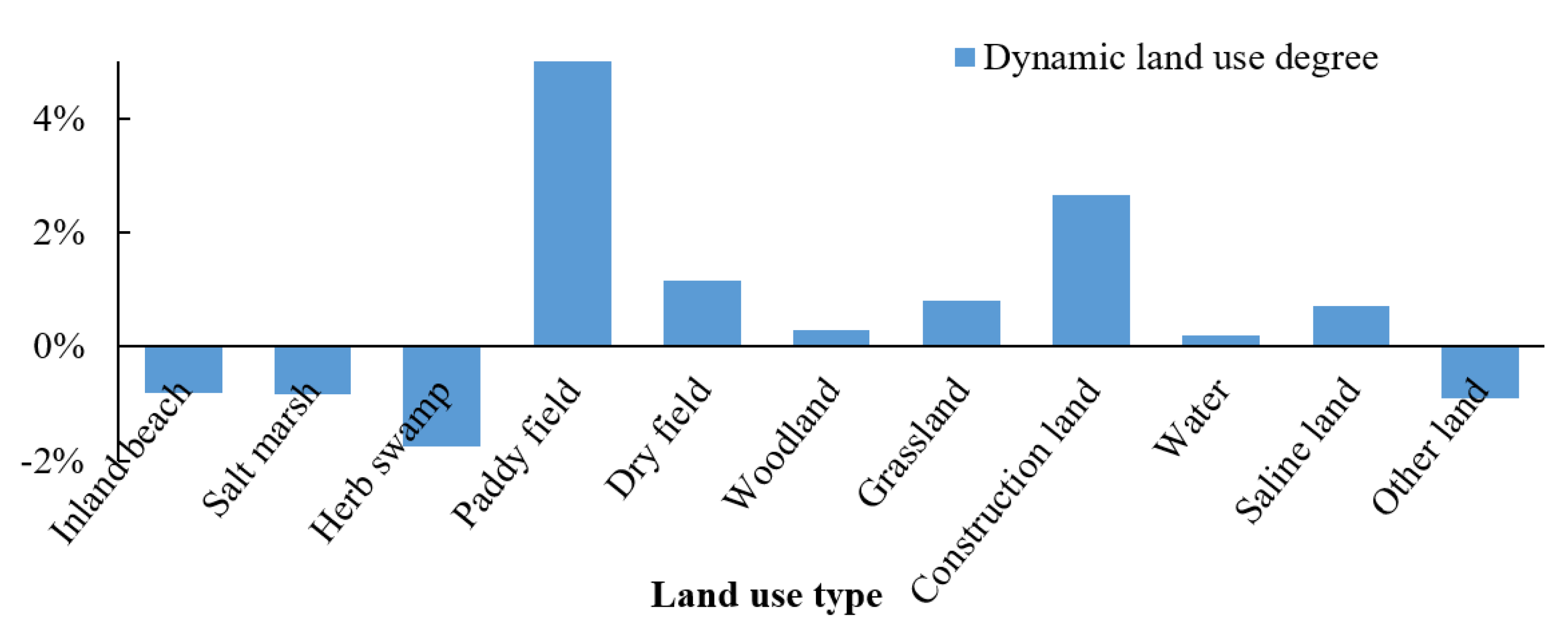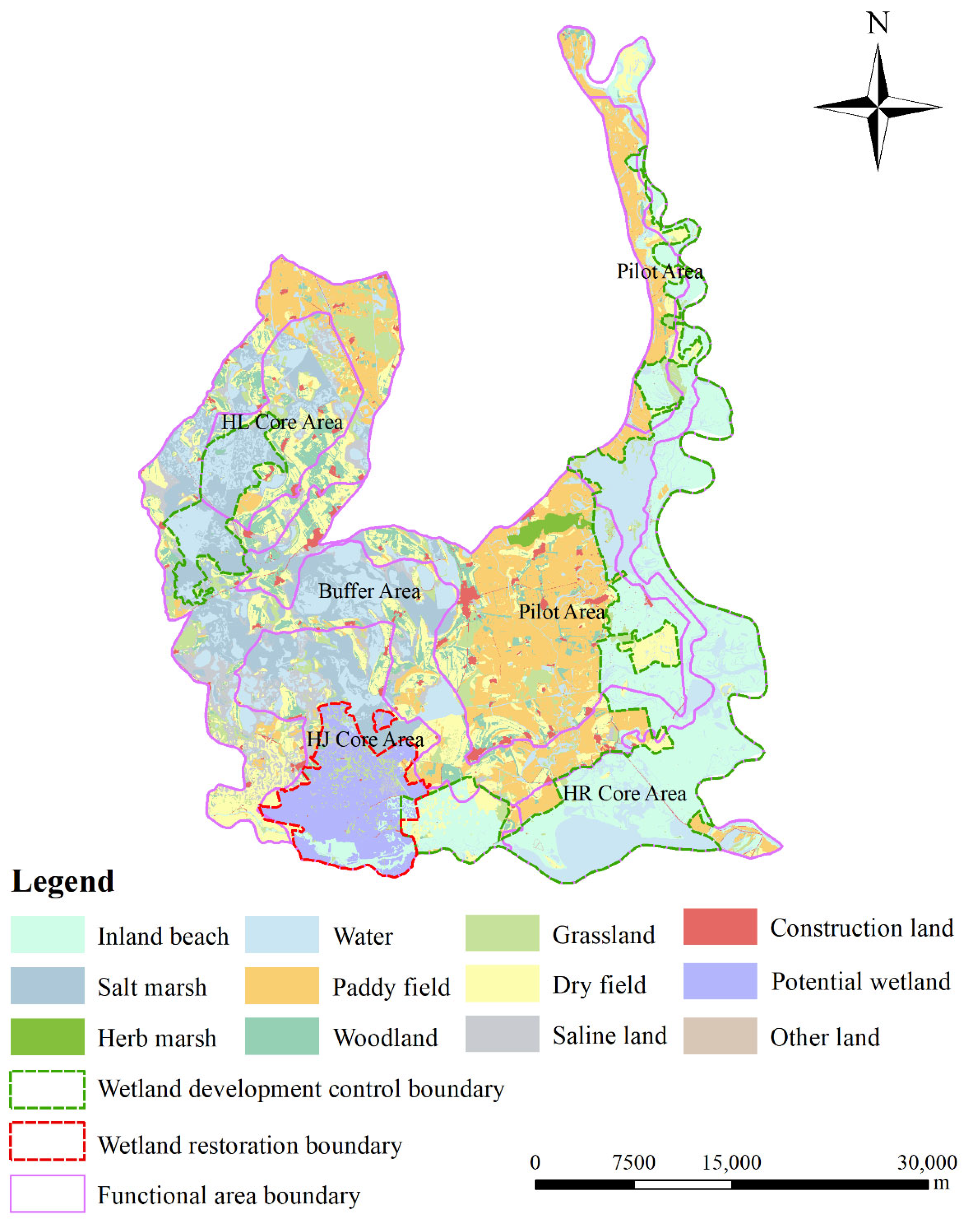1. Introduction
The historical legacy of nature reserves is one of China’s most significant environmental issues. In China’s 474 national nature reserves, there are currently 29 urban built-up areas, 531 built-up areas consisting of formed townships, and 779 administrative villages [
1]. Over the past three decades, scholars have created a variety of frameworks for assessing ecosystem integrity to characterize the natural and wilderness states of unaltered nature reserves. Initially, ecosystem integrity was recommended as a scientific evaluation criterion for ecosystem management in national parks in Canada [
2]. Traditional frameworks for assessing ecosystem integrity and authenticity include the Index of Biotic Integrity (IBI) [
3,
4,
5], the Ecosystem Integrity Assessment Framework (EIAF) [
6], and the Ecosystem Integrity Assessment System Based on Essential Ecosystem Characteristics (EECs) [
7]. In general, local and international scholars have centered their evaluations of ecosystem integrity on environmental stress, ecological processes, and biodiversity [
8].
Wetlands exhibit some combined functions with those of terrestrial and aquatic ecosystems and they are among the most critical ecosystems [
9,
10,
11,
12,
13]. However, the global wetland area has decreased by 35% during the past 50 years (
https://www.global-wetland-outlook.ramsar.org/ (accessed on 17 December 2021)). Land use and development contribute significantly to the loss of wetland habitats. Various reports have discussed the loss of wetlands as a result of land use change, such as the extensive and rapid transformation of natural wetlands in Asia [
14], the loss of 33% of the total domestic wetland in China between 1978 and 2008 [
15], and the extensive conversion of marshland to construction and arable land in China [
16]. The conventional methodology used for assessing ecosystem integrity requires very high-altitude survey data and is challenging to apply to complex wetland habitats. The remote evaluation framework of the Three Level Approach (TLA) has established a number of evaluation indicators that can be evaluated through remote sensing [
17,
18]. On this basis, numerous evaluations of ecosystem integrity have been performed through the adoption of a Geographic Information System (GIS) analysis [
19,
20].
There is an urgent need to develop ecosystem integrity assessment frameworks that can be applied more frequently and repeatedly to nature wetlands to evaluate, monitor, and report on the condition of the region’s ecosystems. Natural wetland parcels are generally fragmented, and delineating multiple natural land use types at fine scales is a limited process. Wetland data from the Third National Land Survey of China (2019) and the Second National Wetland Survey (2013) provide more fine-scale wetland vector data. However, it is difficult to obtain sufficient vector data for most wetland studies. Therefore, few previous studies have studied wetland changes over periods longer than 50 years and studies have failed to explore the more primitive wetland landscapes in history.
Several research findings have emphasized the viability of employing CORONA images to gain information on fine wetland types [
21,
22]. However, it has been noted that CORONA images have certain deficiencies in terms of both feature identification and band calculation [
23]. In this study, we gathered historical information on the research area, such as county records, almanacs, and reports outlining the distribution of wetlands and hydrothermal conditions, to address this issue. In addition, we employed a human visual interpretation technique to adjust the land use change data piece by piece, which dramatically enhanced our ability to identify natural wetland types with precision.
Managing wetland areas with historical legacies is essential in order to safeguard core wetland areas and repair degraded wetlands. In response to numerous unknown factors concerning the degradation and development of wetland areas in the study area [
24,
25], an area of inappropriate development was identified, and the spatial pattern of the wetland areas was modified to meet ecological requirements to the greatest extent possible. In addition to the basic functions of natural wetland systems, wetlands with historical legacies are typically tightly linked to the production activities and living situations of humans [
26,
27,
28]. Consequently, resolving historical legacy issues in wetland nature reserves plays a crucial role in fostering high-quality economic development and high-level ecological environmental protection through synergistic means.
On the basis of RS and GIS technologies, we developed a framework for assessing the integrity of ecosystems that is less expensive and requires less time. Such a framework will not replace assessment methods based on rigorous field surveys, but it will aid in the constant monitoring of changes in ecosystem integrity and provide essential data for addressing legacy concerns in nature reserves. In this study, we investigated the spatial and temporal aspects of a wetland from 1965 to 2019, utilizing the Momoge National Nature Reserve as a case study. On the basis of the “Quality-Pressure-Pattern-Service” ecosystem integrity remote assessment methodology, wetland ecosystem integrity was assessed. The optimization of the spatial pattern in the reserve was also performed to assist in providing fine control over the wetland’s ecology.
3. Results
3.1. Land Use Change Analysis of the Momoge Internationally Important Wetland
3.1.1. Land Use Structure Investigation
The real spatial distribution of Momoge Internationally Important Wetland in 1965, 2015, and 2019 is depicted in
Figure 4. The wetland maps for different years had comparable spatial distributions. The main land cover type in the research region was always wetland, followed by dry field.
The dominant species of wetland was inland beaches, followed by water. Inland beaches and water were primarily distributed along the Nengjiang River in the east and the Tao’er River in the south; salt marshes were primarily distributed in the northwest, where the terrain was slightly elevated; and herb marshes were primarily distributed in the low-lying regions of the south-central portion of the study area. The middle portion of the research region was dominated by arable land. The majority of saline land was found in the depressions surrounding the western lakes and marshes.
3.1.2. Analysis of Wetland Change Spatial Patterns
We focused on two degraded regions, which showed wetlands changed in protected areas, in order to investigate the spatial features of wetland at the regional scale during different years. The first area shown in
Figure 5, was one of the places where wetland loss is the worst, and inland beaches were the most common type of wetland there.
This typical region was considered agricultural terrain. The government carried out agricultural reclamation in the reserve between 1965 and 2015 for the purpose of increasing food production. For instance, the southern herb marsh was almost entirely converted to a mixture of arable land and grassland, whereas the western salt marsh was also reclaimed and even degraded to saline land. From 2015 to 2019, the government converted dry fields to paddy fields in an effort to increase the productivity of arable land use. This measure slowed the encroachment of agricultural space on wetland ecosystems. However, in general, degradation continued to dominate the spatial change of narrow wetlands.
The second location was chosen to illustrate the evolution of water in the western portion of the research area (
Figure 6). A sufficient water supply is required to prevent the salt marsh from degrading into saline land. From 1965 to 2019, the amount of water in this region decreased before increasing. From 1965 to 2015, the conversion of huge dry areas to paddy fields in the study area led to a dramatic increase in water demands for agricultural irrigation, resulting in a substantial decrease in the area of water. Between 2015 and 2019, the area of water in the research region increased by 6344.70 ha, or 31.21 percent. Different hydraulic engineering methods were employed to make sure that there was enough water to keep the wetland ecosystem healthy and to stop the wetland from becoming more salty and growing meadows.
3.1.3. Analysis of Wetland Changes throughout Time
To investigate the temporal aspects of wetland changes, we computed the changes in wetland area from 1965 to 2019 (
Figure 7). Over the two time periods, the areas of both arable land and construction land increased continuously. Wetlands were the only land type of which proportion of the area continued to decline, falling from 75.06 percent to 45.62 percent. The area of every subcategory of wetland except water and salt marsh dropped.
From 1965 to 2019, land use in the Momoge Internationally Important Wetland changed greatly (
Figure 8), and the rates of change for different types of land were very different.
From 1965 to 2019, the area of paddy fields expanded by 24,936.17 ha at the highest yearly growth rate. This was followed by construction land, which increased by 142.67 percent with an annual growth rate of 2.64 percent. With an annual growth rate of 0.69 percent, the amount of saline land grew by 37.49 percent. The area of a narrow wetland was reduced by 53.43 percent, at a rate of 0.99 percent per year. It is likely that non-wetland areas such as arable land, construction land, grassland, and saline land grew at the expense of wetland in the research area.
3.2. Analysis of the Ecosystem Integrity Index
The Momoge Nature Reserve can be separated into three types of areas. The pilot area, buffer area, and core area are listed in descending order of the degree of human activity allowed in each area. The core area consists of the HJ core area, the HR core area, and the HL core area.
In terms of ecosystem integrity rating (
Figure 9), the majority of the Momoge Internationally Important Wetland was in a relatively pristine and untouched state in 1965, with 31.64 percent, 38.83 percent, and 7.81 percent of the territory receiving excellent, good, and medium ratings, respectively. In 2015, 17.95 percent, 23.62 percent, and 13.86 percent of the research area received excellent, good, and medium ratings for ecosystem integrity. Ecosystem integrity was broken in some places, as 36.79% of the areas were rated as having low ecosystem integrity and 7.78% as having extremely poor ecosystem integrity. The 2019 assessment revealed that over half of the study area had an ecosystem integrity rating of poor or extremely poor. Notably, the number of places with excellent and good ratings for ecosystem integrity increased by 0.42 percent and 1.45 percent, respectively.
Figure 9 shows that the ecosystem integrity of the eastern part of the Momoge Internationally Important Wetland was much higher than those of the middle and western parts. Affected by the zoning of the nature reserve, the pilot area in the center of the research area contained the majority of the regions with low ecosystem integrity in 2015 and 2019. This was mostly due to the extensive conversion of herb marsh into paddy field. Secondly, the northwest region of the research area had poor ecosystem integrity. This region was more susceptible to wetland salinization. The regions with a moderate level of environmental integrity were primarily located near dry field and salt marsh. Most of the places with exceptional ecosystem integrity were located near the Nengjiang and Tao’er Rivers, which are very important for conservation.
The analysis of stacked single indicators revealed that elevation and hydrological conditions influence ecosystem quality components. Rare ducks were able to find better places to breed and grow in the HR core area near the water source. The overall distribution of ecological pressure in the research area exhibited a pattern of high pressure in the center, low pressure in the east and west, high pressure in the north, and low pressure in the south. The areas of high ecological pressure were centered on densely populated rural settlements and arable land, and were distributed in points and clusters. We determined that the central and western regions had a high intensity of human disturbance, a high degree of landscape fragmentation, and poor connectivity between wetland patches. Human activities are were weaker in the eastern zone, and wetland patches exhibited positive clustering and extension trends.
3.3. Identification of Unreasonably Developed Areas in the Momoge Internationally Important Wetland
The irresponsible overexploitation of the historical Momoge region ultimately resulted in the rapid degeneration of wetland ecological processes. The results of this study can be used to effectively diagnose historically overdeveloped areas (
Figure 10).
First, we separated the integrated ecological function evaluation value into four grades for the three years to demonstrate the strength of ecological function in different portions of the Momoge Internationally Important Wetland, with the ecological function being stronger the higher the ecological function value. We found that the inappropriate development area in 2015 and 2019 was primarily concentrated in the HJ core area and the adjoining paddy fields within the HR core region that were closer to the buffer zone.
3.4. Delineation for Projects Converting Arable Land to Wetland in the Momoge Internationally Important Wetland
To determine the future boundaries for converting arable land to wetland in the Momoge Internationally Important Wetland, we focused primarily on the identification of the historically over-exploited wetland regions in 2019 and the distribution of wetlands in the area’s original state in 1965.
Figure 11 depicts the precise spatial pattern distribution.
Since agricultural land in the pilot area of the Momoge Internationally Important Wetland has already been acquired on a large scale, it would not be possible to convert the arable land to inland beach in the foreseeable future. Therefore, we proposed to maintain the area of arable land in the pilot region and further improve ecological function by converting dry fields to paddy fields (refer to 2015, where areas of dry field have changed to areas of paddy field).
The Momoge Internationally Important Wetland, arable land, woodland, grassland, construction land, and saline land will be adjusted to 72,565.84 hectares, 8332.43 hectares, 4564.55 hectares, 3115.80 hectares, 8389.77 hectares, and 6979.55 hectares, respectively. Based on our assessment of the ecosystem’s integrity and the nature reserve’s future development trends, we drew the wetland control development boundaries of the research area to conserve wildlife-habitat wetlands. Both the eastern and western halves of the nature reserve contain sufficient wetland habitats. In addition, in the pilot area, moderately developed for agricultural purposes could be permitted. For the inappropriate development area in the southern HJ core region, the project of converting arable land to wetland was given priority.
4. Discussion
4.1. Comparative Analysis of the Results
Taking the Momoge National Nature Reserve as an example, the main objective of this study was to evaluate the ecosystem integrity of the study area in 1965, 2015, and 2019. On this basis, unreasonable developed regions were identified, and the restoration of wetland habitats was prioritized. First, we presented a framework for the remote assessment of the integrity and authenticity of ecosystems. Land use data were used to assess the dynamic changes of wetlands. Using the framework provided in this article, we investigated the spatial and temporal trends of ecosystem integrity. Based on the ecosystem integrity index, we identified inappropriately developed regions and determined wetland restoration boundaries.
Most previous studies have concentrated on a single aspect of a wetland’s historical evolution or ecological function evaluation [
46,
47]. However, few studies have been conducted on wetland restoration through the evaluation of ecosystem integrity and authenticity. Ecosystem authenticity and integrity are mutually integrated and holistic concepts, and integrity is more widely discussed in ecology than authenticity.
Land use change is the primary cause of wetland degradation [
48,
49,
50]. Agriculture, the most common cause of land use change, has destroyed more than 50 percent of the internationally significant wetland habitats worldwide [
51,
52]. Dong, Z. et al. and Wang, Z. et al. researched the processes and causes underlying wetland fragmentation and contraction, and they discovered that agricultural growth in the context of climate change was the primary cause of the massive loss of wetland in the western Sonnen Plain [
53,
54].
The simultaneous stress of climate change and human disturbance has destabilized the wetland’s basic ecological structure and constitutes a grave threat to the ecosystem [
55]. The lack of water in wetlands is the primary cause of the considerable decline in ecosystem integrity in Momoge National Nature Reserve. Changes in land use type were spatially concentrated in the HJ core and the central pilot area, where wetland development has historically been more intense. Jilin Province’s 14th Five-Year Plan for Ecological Protection projected a 60 percent effective rate of wetland protection by 2035.
In environmental integrity and authenticity evaluations, one may use an undisturbed or slightly disturbed ecosystem as a reference standard. In the current context of human growth, few ecosystems remain untouched by human activity. As a result, the natural state (e.g., the state closest to the natural habitat in a regional ecosystem) is typically used as the benchmark in studies. In 1965, the study region had relatively few human disturbances. Therefore, the spatial pattern of the study area was optimized using the level of ecosystem integrity in 1965 as a standard. In this study, the restoration boundary and protection boundary of the wetland was not limited by those of the three original types of functional areas of protected areas.
4.2. Sustainable Development Measures
The following suggestions are provided for the future development of the Momoge Internationally Important Wetland.
- (1)
Promoting the project of converting arable land to wetland and increase the quality of arable land.
From 1965 to 2019, the population density of the study region increased from 16 to 29 people per square kilometer, resulting in an increase in the local population’s demand for food. In this setting, if managers continue to increase the amount of arable land by reclaiming wetland, woodland, and grassland to fulfill increased agricultural production needs, the study area’s ecology will be affected by even more dire problems. Several studies have suggested that measures such as “rewetting” and water penetration can be used to mitigate the adverse effects of overexploitation on wetland ecosystems [
56,
57]. Wetland managers must give the ecological environment the highest priority. The project of converting arable land to wetland is executed gradually in historically overexploited areas, with farmers receiving compensation for the loss of land, in compliance with national legislation. Farmers are also urged to enhance the quality of arable land through reclamation or preparation.
- (2)
Enhancing the hydrological connectivity of wetlands and restoring wildlife habitats.
In the past 50 years, climate-related droughts and human activities have contributed to a diminishing supply of water in the Momoge wetland. To restore the quality of waterfowl habitats, we can, on the one hand, execute water system penetration projects and remove unneeded ditches to restore the hydrological system in the study area to its original state. Alternatively, we should conserve the natural reed belt surrounding the habitats of waterfowls, such as whooping cranes, to separate human activity from the birds’ breeding grounds. These techniques will aid in maintaining the stability of the wetland ecosystem to restore these habitats for birds and other animals.
4.3. Uncertainties and Prospects
There are numerous unknown factors relating to the deterioration and development of wetlands in the research area, including policy shifts, population expansion, and climate change. The objective of wetland spatial pattern optimization is not to predict the future exactly, as there are innumerable uncertainties involved, but to explore the potential of the restoration of wetlands in the future in a way that meets biological needs as much as possible.
The remote evaluation approach provides quick assessments of ecosystem integrity, although the framework has some shortcomings. First, the data processing methods used for certain indicators must be enhanced. Due to the limited availability of data, we did not consider many variables that are strongly related to biodiversity. Secondly, the accounting technique for ecological service values must be enhanced. Thirdly, the assessment framework did not effectively take into account the indicators that are used to judge how pristine an ecosystem is. In future research, we will thus consider introducing the spatial and temporal distributions of rare species such as
Grus leucogeranus, utilizing the InVEST model to address the effects of climate change or anthropogenic disturbances on ESV [
57], and introducing remote metrics aimed at characterizing the authenticity of ecosystems.
5. Conclusions
In this study, we combined the EIAF, TLA, and PCFAEI models to develop a “Quality-Pressure-Pattern-Service” remote assessment framework, investigating the ecosystem integrity pattern of the study area, and identifying wetland restoration boundaries and wetland development control boundaries. This framework is an efficient tool for assessing the environmental impact of complex ecosystems. Our research was less costly and applicable on a broader regional scale than conventional methods. In general, the framework can be easily updated and repeated regularly, providing additional data for continued adaptive-management.
The “Quality-Pressure-Pattern-Service” ecosystem integrity remote assessment framework can be broken down into four indices: the ecosystem qualityindex, the ecosystem stress index, the ecosystem pattern index, and the ecosystem service value index. These indices can be used as a set of indicators for natural resource agencies and organizations to monitor the condition of ecosystems. The information gathered to create these indexes can be used to create databases and atlases depicting the condition and trends of important nature reserves. The framework can also be used to identify areas of unreasonable development that need to be prioritized for ecological restoration, while highlighting areas that need to be protected. It can help managers to improve spatial patterns and create ecological restoration targets for entire ecosystems.
In future studies, this remote evaluation system will be integrated with a spatial pattern simulation model. The consequences of land use changes on ecosystem integrity will be investigated under several scenarios based on future simulations.
